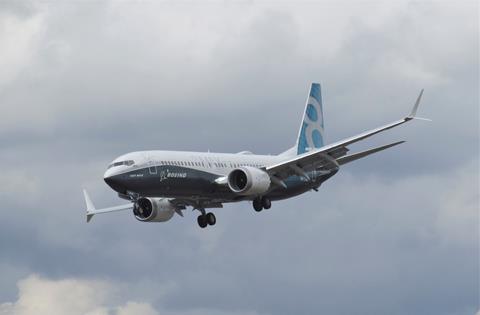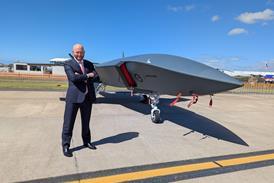The Federal Aviation Administration (FAA) has suggested four key design changes to the beleaguered Boeing 737 Max in order to address safety issues that led to its almost 17-month grounding following two fatal crashes that killed 346 people.
The regulatory body says on 3 August that it is proposing a new Airworthiness Directive (AD) that will allow the aircraft to once again return to service. The AD includes proposals that will enhance the safety of the aircraft as well as the ability of the cockpit crew to deal with potential issues.
Though the FAA completed three days of flight tests on 1 July, there is still no indication of when the jet will be released to fly again in revenue service. The aircraft’s recertification flights were an important milestone in the process to bring the troubled aircraft back, but numerous steps are still required.

“This proposed AD would require installing new flight control computer software, revising the existing Airplane Flight Manual to incorporate new and revised flight crew procedures, installing new Max display system software [and] changing the horizontal stabilizer trim wire routing installations,” the FAA writes on 3 August.
The new flight control software is intended to prevent erroneous activation of the aircraft’s manoeuvring characteristics augmentation system (MCAS), which was determined to be a primary cause of the two crashes, in October 2018 and March 2019.
In addition, revisions to the flight manuals and alerts to the pilots are conceived to ensure that crew can correctly recognise and respond to a potential angle of attack sensor failure – a key piece of equipment for the MCAS system.
The final design point, changing the trim wire routing, “is intended to restore compliance with the FAA’s latest wire separation safety standards”, the FAA says.
The agency has now opened up a 45-day period during which it invites comment on the proposed AD.
In addition to these four changes, the FAA’s proposed AD includes a requirement that operators conduct an angle-of-attack sensor system test and perform an operational readiness flight prior to returning each airplane to service.
The FAA estimates that this AD will affect 73 US-registered aircraft costing the operators a total of about $1 million altogether (excluding the cost of the operational readiness flight). The most expensive repair is projected to be the stabilizer wiring, the FAA says. Boeing must make the changes on the aircraft that it had not yet delivered prior to the grounding.
According to Cirium fleets data, the biggest US operators of the 737 Max are American Airlines, United Airlines and Southwest Airlines.
The notice of proposed rulemaking does not include proposed requirements for pilot training, which it will publish later the FAA says. ”Pilot training will be evaluated by the Joint Operations Evaluation Board (JOEB) and the FAA’s Flight Standardization Board (FSB),” the agency says.
”The FAA intends to assure the global community that when the work is completed, the 737 Max will be safe to operate and meet FAA certification standards,” the FAA writes in its preliminary review of the Boeing 737 Max’s return to service, also published on 31 July. ”Through a thorough, transparent, and inclusive process, the FAA has preliminarily determined that Boeing’s proposed changes to the 737 Max design, flightcrew procedures and maintenance procedures effectively mitigate the airplane-related safety issues that contributed to the… accidents.”
In early July, a US government watchdog issued a scathing report that blasted Boeing for misleading regulators and purposefully holding back information about MCAS during the aircraft’s certification process. The FAA was kept in the dark about potential dangers of the flawed system, and therefore it was not able to adequately test or otherwise address it before the aircraaft was originally certificated.
Last week, Boeing told investors that it intends to deliver a majority of its 450-strong 737 Max stockpile within one year of resuming deliveries of the still-grounded jet. Boeing accumulated those aircraft because it continued manufacturing the Max through most of 2019 despite being unable to deliver the jets due to the worldwide grounding.


























